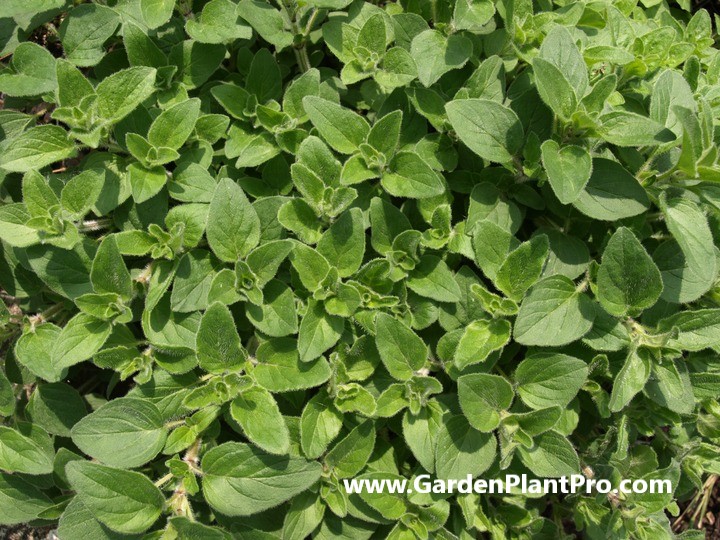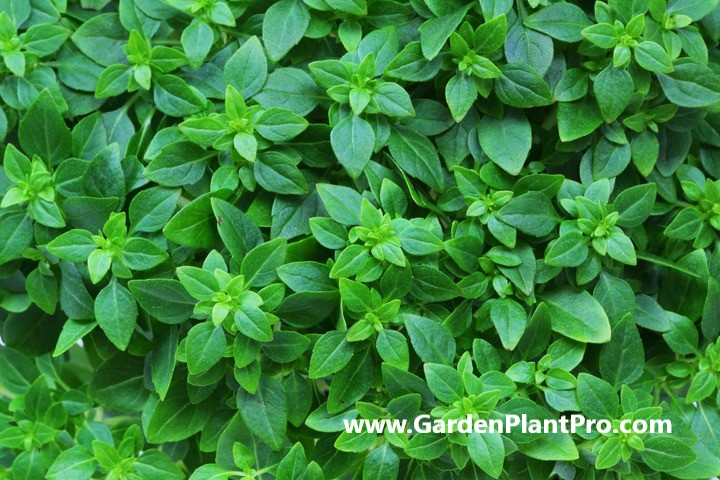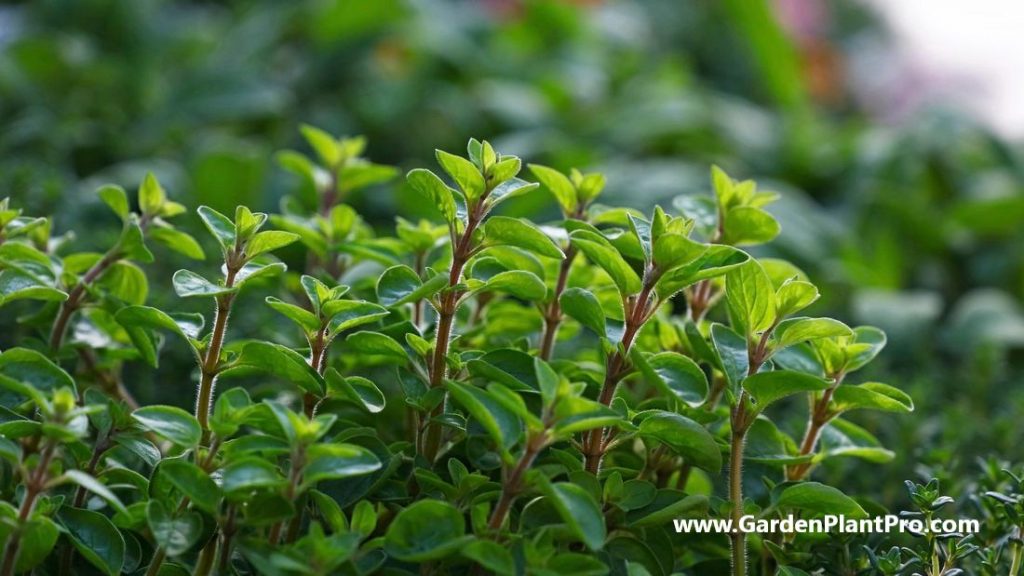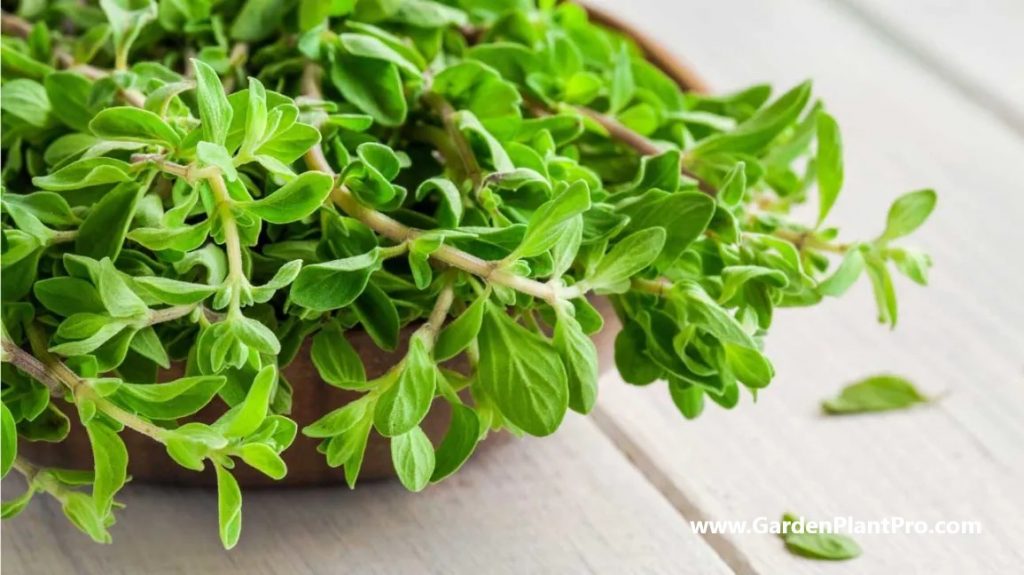Try planting marjoram in your garden if you’re a home gardener looking to add some savory and aromatic herbs to your collection. This simple-to-grow plant belongs to the mint family and is noted for its delicate, sweet flavor and pleasant scent. With the appropriate growth conditions and a little care, you can enjoy a plentiful harvest of fresh marjoram right in your own garden.
In this guide we’ll walk you through the process of growing marjoram in your own backyard, from sowing the seeds to harvesting and utilizing the herb in your recipes. So let’s get started and infuse your life with some fresh, tasty marjoram!
A Brief History
Marjoram is a perennial herb whose history can be traced back to ancient Greece. It has been widely used in cooking and medicine for centuries, and it is believed to have originated in the Mediterranean region.
Marjoram was widely used in ancient Greece as a medicinal herb to treat a variety of ailments. It was also used for its culinary qualities, with its distinct flavor being highly sought after.
In the Middle Ages, marjoram was widely cultivated throughout Europe and spread to North America during colonial times. It is still widely used in cooking today and is an important ingredient in many dishes from around the world.
In traditional herbal medicine, marjoram is believed to have calming properties and is often used to help ease anxiety, stress, and depression. It is also thought to help with digestive issues, headaches, muscle aches, and even arthritis.
Marjoram oil has been used in aromatherapy for centuries and is believed to help open up airways and soothe breathing problems. The essential oil can also be used to relieve tension headaches when massaged into the temples or neck area.
Marjoram has certainly stood the test of time and continues to be a popular choice for both culinary purposes as well as medicinal applications. Whether you are looking for an ingredient for your favorite dish or want to explore the health benefits of this beloved herb, marjoram is definitely worth adding to your garden!
Nutritional Benefits
Marjoram is a popular herb that offers a wide range of health benefits. It is loaded with essential vitamins, minerals and antioxidants that can help to improve overall health.
Marjoram is a good source of vitamins A and C, as well as folate, potassium, magnesium and calcium. The herb also contains phytochemicals such as carvacrol and thymol, which are known to have anti-inflammatory and antiseptic properties.
The essential oils in marjoram are known to have healing properties. Studies have shown that marjoram can help to reduce inflammation in the body, which can help to improve overall health and wellbeing.
Marjoram can also help to regulate hormones in the body, which can lead to improved skin health and menstrual regulation. Additionally, marjoram is believed to improve digestion by promoting the production of digestive juices.
Marjoram is also rich in antioxidants, which can help to reduce the risk of certain diseases such as heart disease, cancer and diabetes. Antioxidants are also known to protect the body from free radicals that can damage cells and cause premature aging.
If you are looking for a natural way to boost your health, marjoram may be a great choice. There are many ways to incorporate marjoram into your daily diet – you can add it to salads or soups, sprinkle it on roasted vegetables, or make a tea with it.

Common Varieties & Their Uses
Marjoram is an herb that comes in many varieties, each with its own unique flavor and uses.
Sweet marjoram is the most common variety, and is typically used as a seasoning in cooking. It has a sweet, mild flavor that works well in salads and other dishes. Another popular variety is pot marjoram, which has a more intense flavor than sweet marjoram and works well in stews, soups, and sauces.
Another type of marjoram is oregano. It is a cross between sweet marjoram and wild marjoram, and it has a robust flavor that works well in Mediterranean dishes. It’s also popular for use as a pizza topping or for adding flavor to tomato sauce.
Wild marjoram is a perennial herb native to the Mediterranean region. It has small flowers that appear in summer and has an intense, spicy aroma and flavor. It’s often used to make herbal teas or to season salads and vegetables.
Marjoram can be grown from seed or cuttings, and it prefers full sun and well-drained soil. When planting marjoram, make sure to give it enough space to grow without overcrowding other plants. Water moderately, but avoid over-watering as this can lead to root rot or disease.
To harvest, pick individual leaves as needed throughout the growing season or pick the stems just before the plant flowers (the flavor suffers after flowering). Marjoram can be stored by drying or freezing the leaves or stems.
DIY PROJECT: Collect rainwater no matter where you live...
This DIY project is the best way to legally collect rainwater NO MATTER where you live. Get chlorine-free water, cut down on your water bills, and have enough for an emergency situation or to water your garden. Read More Here...
When To Sow
When it comes to sowing marjoram, there are a few important things to consider.
It’s best to start the seeds indoors during late winter or early spring, pushing seeds just below the surface of a small pot filled with seed compost. To speed up germination, soak seeds in water overnight. For the best results, plan to sow seeds six to eight weeks before the last frost, in early spring.
For outdoor planting, wait until after the last frost of the season and make sure the soil temperature has reached at least 60°F (15°C). Fill your container of choice with a light, well-draining potting mix and sprinkle the seeds onto the surface of the mix. Cover with a light layer of soil and keep moist until germination occurs. Thin seedlings as they develop so that each plant has enough room to grow.
If you choose to buy young sweet marjoram plants instead of sowing your own seeds, make sure they get plenty of sun. Sweet marjoram is slow-growing, so you will want to give it full sun, meaning at least six hours of direct sunlight on most days. If you’re growing indoors, choose the window with the most light or invest in some artificial lighting.
Choose The Right Location
When choosing the right location for growing marjoram, it is important to consider the needs of the plant. Marjoram does best in a sunny spot with light, well-drained soil. It requires a lot of light and should receive at least six hours of direct sun per day. If you don’t have a suitable spot in your home, you can grow it indoors near a large south or north facing window or windowsill.
When planting outdoors, wait until the last chance of frost has passed in the spring and select a warm and sheltered spot with well-draining soil. Container growth is also an option; just make sure to choose a premium organic potting mix designed for herbs and vegetables.
For best results, monitor the soil temperature before planting. The ideal temperature for marjoram is 70°F (21°C). You can easily check this by using an inexpensive soil thermometer. Once you have selected the right spot and prepared the soil, you can start planting your seeds, seedlings or cuttings.
Prepare The Soil
Preparing the soil is an essential part of growing marjoram successfully. It should be done prior to sowing seeds, planting seedlings or cuttings. The soil should be loose and well-drained. A pH of 6.7 to 7.0 is recommended. Adding organic matter such as compost or aged manure will help improve the soil structure and fertility. To make sure the soil is not compacted, it may be necessary to dig or rake it before planting. It is also important to remove any weeds that may be present in the area.

Plant The Seeds, Seedlings Or Cuttings
When it comes to planting Marjoram, you can choose between planting seeds, seedlings, or cuttings.
All methods are viable and depend on the desired result and your timeline.
When sowing seeds, sprinkle them on prepared ground and cover with a 1/4 inch of soil. Make sure to keep the soil damp but not wet during germination.
If you’re sowing seeds indoors and it’s best to start the seeds during late winter or early spring. The seeds of marjoram are very tiny, so making sure to spread a thin layer of soil over them is important. To speed up germination, it is recommended to soak them in water overnight before planting.
When sowing seedlings or cuttings outdoors, space them about a foot apart and situate them at the same depth they were growing in their previous container.
Planting seedlings or cuttings should be done by loosening the roots from the potting medium and spreading them out in a hole that is twice as wide and deep as the root ball of the marjoram plant. Fill in around the roots with a mix of equal parts compost and garden soil before lightly tamping down the soil to eliminate air pockets.
Watering in can help settle the roots into place and prevent them from drying out too quickly.
For pot-sized plants that can be grown indoors all year round, fill a small pot with seed compost and sow a few seeds on the surface before covering with a light layer of soil. Marjoram grows best in potting mixes with good drainage designed for cacti or succulent plants.
You can also create a DIY soil blend using one part loam soil, one part organic matter such as compost or manure, and one part builder’s sand. Make sure to water the soil before planting and don’t forget to place your potted marjoram in an area that receives plenty of light.
Do you have some charcoal in your house right now? We call charcoal a “miracle leftover” for anyone who wants to be a little more self-sufficient and cut costs. That’s because it can help you with so many different things around the house and garden. You can even use it to make an energy-free fridge. Read More Here...
Taking marjoram cuttings is another simple and effective way to propagate the herb and increase your yield without having to plant more seeds or buy new plants. Follow these steps to take cuttings from your existing marjoram plant:
- Choose a healthy, mature marjoram plant to take cuttings from. Look for a plant that is at least 6-8 inches tall and has multiple stems.
- Using a sharp and sterile pair of scissors or pruning shears, cut a stem of marjoram that is about 4-6 inches long. Make sure to cut just below a leaf node, which is where the leaves attach to the stem.
- Remove the leaves from the bottom 2-3 inches of the stem, leaving a few leaves at the top. This will help the cutting focus its energy on growing new roots.
- Dip the cut end of the stem in rooting hormone powder to encourage root growth.
- Plant the cutting in a small pot or container filled with moist potting soil. Make a small hole in the soil with a pencil or your finger, insert the cutting, and gently press the soil around it.
- Cover the pot with a plastic bag or dome to create a humid environment and retain moisture. Place the pot in a warm, bright spot but out of direct sunlight.
- Keep the soil moist but not waterlogged, and mist the cutting regularly to maintain humidity.
- After a few weeks, the cutting should start to develop new roots. You can gently tug on the stem to check if it has rooted. Once the cutting has established roots, you can transplant it into a larger container or directly into your garden.
By taking cuttings from your marjoram plant, you can easily propagate the herb and create a thriving garden of flavorful marjoram to use in your cooking.
No matter which planting method you choose for your Marjoram plants, it is important to give them plenty of care and attention to ensure they grow healthy and thrive in their environment.
Watering
Watering is an important part of growing marjoram at home. When seeds emerge or cuttings produce roots, use a liquid feed to help growth. Established plants require little care other than occasional watering. Since marjoram is tolerant of drought, it makes an exceptional plant for container gardening. Keep plants trimmed by cutting the leaves throughout the growing season.
The best watering policy is to wait until the soil surface is completely dry before watering. About 1 inch of water per week should do. For young plants, keep the soil mildly damp but not saturated. Established plants have good drought-tolerance, though you shouldn’t allow the soil to dry out completely.
When planting seeds or seedlings, water moderately and keep the soil moist. Once established, water marjoram regularly until it establishes well in the pot. Once mature, water the plants only when the topsoil is dry. Do remember that constant moist soil can cause root rot in marjoram so be sure to check moisture levels regularly.
Fertilizing
Fertilizing is an important part of marjoram plant care, although it’s not essential. Marjoram is hardy enough to care for itself, and you don’t need to use fertilizer to ensure a good harvest. However, if you do want to feed your marjoram plants, there are several options available.
For best results, opt for a liquid fertilizer formulated specially for herbs. Follow the instructions on the packaging when applying the fertilizer, and feed your marjoram plants once a month during the growing season. You can also use a half-strength, balanced fertilizer as an alternative.
You can also give your marjoram plants a boost by applying a liquid fertilizer after trimming growth after flowering in summer. This will help keep the plants compact and encourage further growth.
Finally, you may wish to pair your marjoram plants with companion plants that act as natural fertilizers, such as legumes or vegetables like beans or peas. This will provide extra nutrients for your marjoram without the need for additional fertilizers.

When & How To Harvest
Harvesting marjoram is an important step in ensuring that your plants remain healthy and productive. The right time and technique can make all the difference.
The best time to harvest marjoram is before the flowers open, as this will give you the most intense flavor. Once the plants are 4-6 inches tall, you can start harvesting fresh leaves as needed. Cut stems before plants flower to stimulate fresh growth.
When harvesting marjoram, use scissors or clippers to snip off the branches and flowers as needed. Avoid taking more than a third of the plant at any one time, as this can damage the plant’s health. If you want a large harvest, consider investing in a pair of garden shears or pruning shears for more precise cutting.
Storing & Preserving
Once the marjoram has been harvested, the best way to store it is to dry it. Tie the stems together and hang them upside down in a well-ventilated area of the house. Once completely dry, the leaves can be removed from the stems and stored in an airtight container.
Alternatively, marjoram can also be frozen for future use. To do this, finely chop the leaves and place them in ice cube trays before freezing. Once frozen, transfer the cubes to a freezer bag and store in the freezer until needed. For best results, use frozen marjoram within 3 months of freezing.
Common Diseases & How To Control Them
Marjoram is largely free of diseases, but it can be affected by root rot, rust, and mildew.
To prevent these diseases from occurring, it’s best to remove weeds and garden debris to eliminate alternate hosts. They also thrive in hot and dry conditions, so mist plants regularly and use biological control in the greenhouse.
CASE STUDY: We've been living off the grid for the last 40 years...
In all that time an electric wire has never been connected to our house. We haven’t gotten or paid an electricity bill in over 40 years, but we have all the electricity we want. We grow everything we need, here, in our small backyard. We also have a small medicinal garden for tough times. Read More Here...
Root Rot is a common disease of marjoram caused by a fungus that can survive in moist soil. To prevent this disease, avoid over-watering and ensure good drainage. If you suspect that your plants may be infected, you can apply a fungicide to help prevent further spread of the disease.
Rust is caused by a fungus and is characterized by red-brown spots on the top of the leaves. This can be prevented by providing adequate ventilation and avoiding damp conditions. If your plants are infected, you should remove any affected leaves and apply a fungicide to help prevent further spread of the disease.
Mildew is a fungal disease that affects marjoram plants and is characterized by white or gray spots on the top or undersides of leaves. This can be prevented by providing adequate air circulation and avoiding damp conditions. If your plants are infected, you should remove any affected leaves and apply a fungicide to help prevent further spread of the disease.
Common Pests & How To Control Them
Marjoram is a popular herb that has been used for centuries, so it is no surprise that it is prone to pests. One of the most common pests for marjoram is the peach aphid (Myzus persicae).
This tiny, green, tear-drop shaped insect loves to feed on marjoram and can quickly cause damage to the plant. If you already have an infestation, there are a few remedies that can help.
First, they thrive in hot, dry conditions so misting your plants regularly can help keep them away. Second, you can use biological control methods like releasing beneficial insects like lady beetles or lacewings in the greenhouse environment if your plants are grown indoors.
Finally, using a fast acting broad spectrum insecticide based on natural, low toxic and organic ingredients can help get rid of any existing infestations.
Companion Planting
Companion planting is a great way to maximize your herb garden and ensure that each plant is getting the most out of its environment. Marjoram is an all-purpose companion plant with many beneficial effects when planted near other vegetables.
It is said to have a beneficial effect on most vegetables and can be planted among garlic chives, sage, rosemary, and chamomile. Planting marjoram near nasturtiums can also act as an insect repellent. When planted in full sun and on poor soil, its fragrance will be intensified.
Marjoram can be grown in containers, both indoors and outdoors, and is relatively easy to cultivate. Planting it among other herbs or along the edges of flower beds can give you a beautiful herb garden without taking up too much space.
When it comes to caring for your marjoram companion plants, make sure to water them regularly and provide enough fertilizer to meet their needs.

Using Your Harvest
Once your marjoram is ready to harvest, you can use it fresh or dried.
Fresh marjoram leaves can be used in salads, sandwiches, soups, stews and sauces. They also make a great addition to marinades or to flavor roasted vegetables.
To dry the leaves, tie the stems together and hang bunches upside down in a cool, dark spot. The leaves should be dry within two weeks. Once they are dry, crumble them into a jar or other airtight container and store in a cool, dry place.
Marjoram leaves have a strong flavor and aroma and are often used in conjunction with other herbs such as oregano, basil, thyme and rosemary. It pairs well with fish, pork and poultry dishes as well as eggplant-based dishes like ratatouille. Marjoram also pairs nicely with vegetables like potatoes and mushrooms. It can also be used to season sauces like tomato sauce for pasta dishes or pizza.
Marjoram essential oil can also be extracted from the leaves using steam distillation. The essential oil has antiseptic properties that makes it an ideal ingredient in natural cleaning products. It is also believed to have calming properties that can help ease anxiety and promote relaxation when used in aromatherapy applications.
Whether you use it fresh or dried, marjoram is a versatile herb with many culinary uses and health benefits. With proper care and harvesting techniques, you can enjoy its flavor all year round!




